Key takeaways:
- Climate action combines individual choices, community involvement, and effective communication to foster change.
- Organizing engaging activities, such as clean-ups and sustainability potlucks, inspires collective participation and education.
- Sharing personal success stories and experiences encourages others to reflect on their contributions and take action towards sustainability.
- Celebrating milestones and maintaining regular check-ins strengthens long-term commitment to sustainable practices within the community.

Understanding climate action
Understanding climate action begins with recognizing its urgency. I remember the first time I truly understood the implications of climate change; a documentary showed coral reefs dying and polar bears struggling to find ice. It hit me hard—how could I stand by while such beauty and life were at stake?
Climate action isn’t just about large-scale government policies; it’s also about individual choices. Have you ever sat down and thought about how your daily habits affect the planet? I started tracking my carbon footprint, and it was eye-opening. Simple adjustments, like reducing meat consumption and opting for public transport, felt empowering.
Moreover, climate action requires collective effort, which can sometimes feel daunting. When I organized a community clean-up, I was surprised to see how quickly others wanted to help once they understood the impact of litter on their local parks. It made me realize that when people grasp the stakes, they often rally together to push for change.
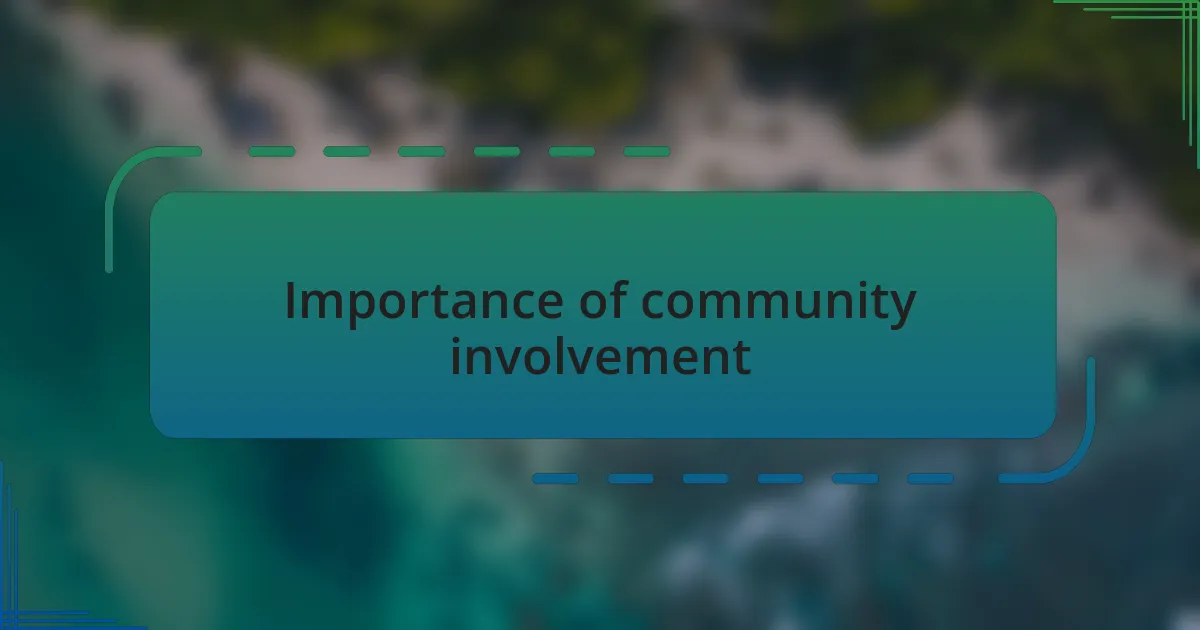
Importance of community involvement
In my experience, community involvement elevates climate action from individual effort to a shared mission. I remember standing in a circle with neighbors during a local sustainability meeting, each of us sharing our concerns about the environment. It struck me how, when voices come together, they create a chorus of advocacy that can compel change far greater than any single voice could manage alone.
Engaging with my community has also fostered deeper relationships. One time, during a tree-planting event, I met a local artist who used his talents to raise awareness about climate issues. This connection sparked ideas on using art as a medium for activism. When we collaborate like this, we don’t just fight for the planet; we empower each other, building a network of passionate individuals committed to making a difference.
Ultimately, community involvement amplifies awareness and education. After facilitating workshops on sustainability, I saw firsthand how knowledge can ignite passion. People left inspired to take action in their own lives. Isn’t it powerful to think that by coming together to share knowledge and experiences, we can educate and motivate the entire community to adopt sustainable practices?
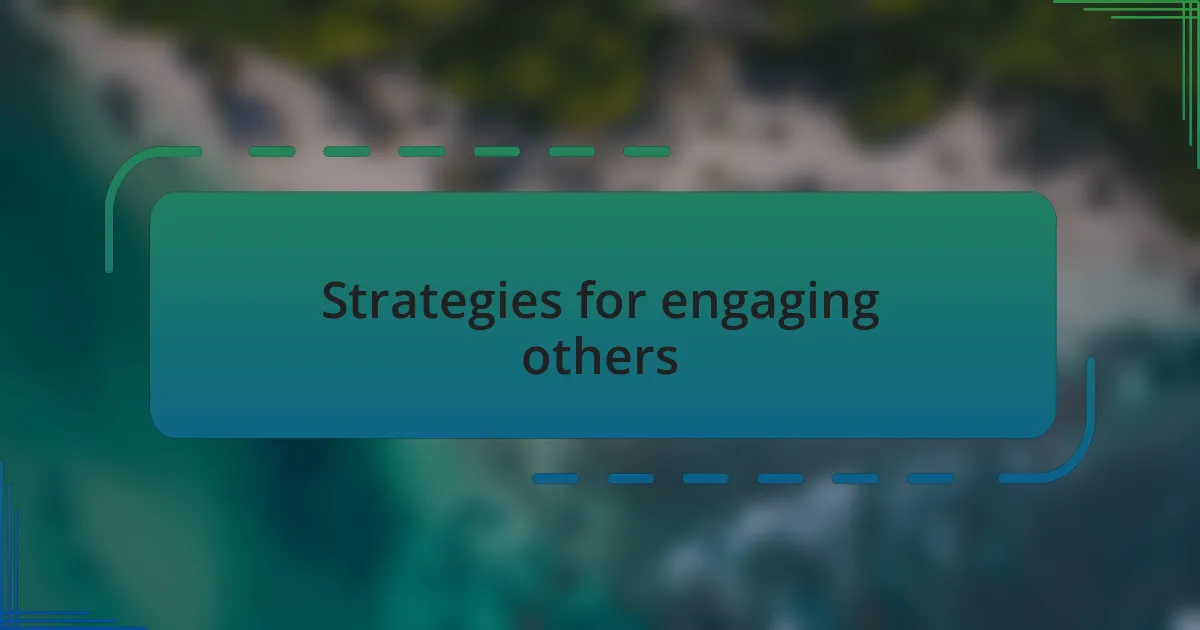
Strategies for engaging others
Organizing local clean-up events is one of the most effective strategies I’ve implemented to engage others in sustainability. I recall one sunny Saturday when I rallied friends and neighbors to clean up a nearby park. As we picked up trash, we laughed and shared stories, transforming a simple chore into a joyful community gathering. Can you imagine the impact of turning a mundane task into an enjoyable experience? It sparked conversations about the importance of keeping our environment clean and inspired many to take further action.
Another approach that worked remarkably well for me was hosting “sustainability potlucks.” Everyone brought a dish made from local ingredients or shared a recipe that minimized waste. The atmosphere was filled with creativity, as we swapped recipes and cooking tips. By making sustainability a fun and delicious experience, I found that people were more willing to embrace eco-friendly practices in their everyday lives. It’s fascinating how food can be a bridge to deeper discussions about the environment.
I’ve also found that storytelling is a powerful tool for engagement. During a recent community forum, I shared my personal journey towards adopting a zero-waste lifestyle, complete with both successes and setbacks. People were captivated, eager to relate their own experiences. When you share authentic stories, audiences see themselves in those narratives. Have you ever noticed how personal anecdotes can resonate deeply? They not only humanize the cause but motivate others to reflect on their own contributions to sustainability.
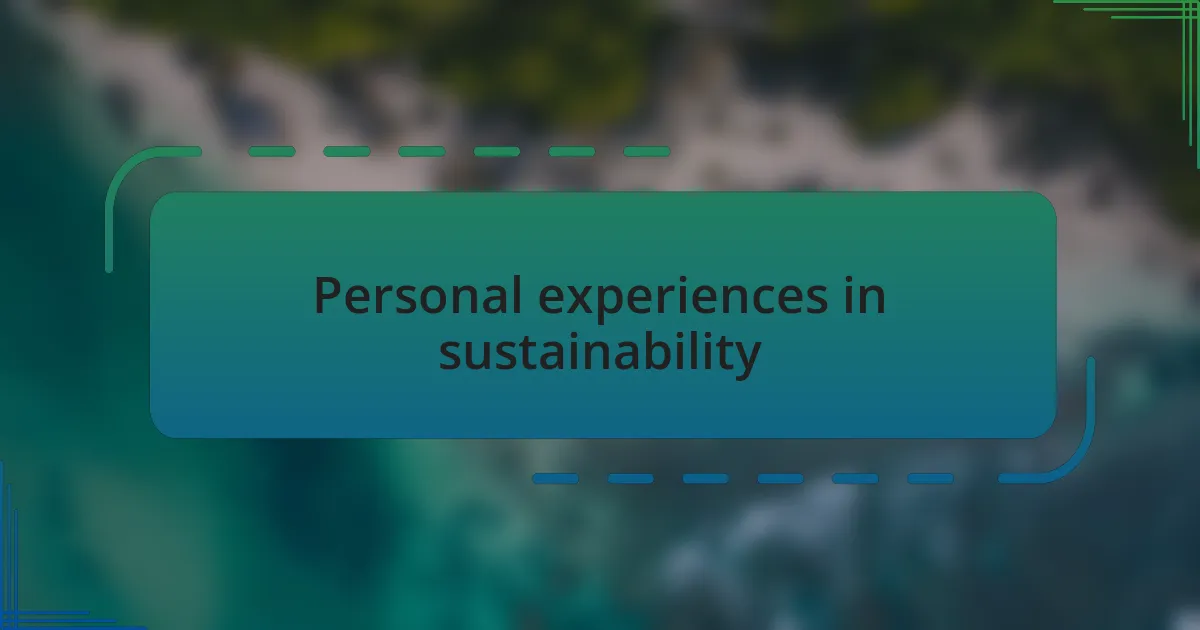
Personal experiences in sustainability
One of the most memorable experiences I had in sustainability was when I decided to convert my backyard into a small vegetable garden. I vividly remember the first time I planted seeds. It was spring, and the smell of fresh soil filled the air as I envisioned the vibrant vegetables I would soon harvest. Watching the plants grow was not just rewarding; it opened a dialogue with my neighbors who, seeing my efforts, began sharing their gardening tips. Have you ever experienced that sense of community sprouting from a shared love of nature?
Another impactful moment occurred during a local Earth Day event I organized. We set up booths focusing on different aspects of sustainability—everything from composting to energy conservation. The excitement in the air was palpable as families engaged with the interactive displays. I learned a valuable lesson that day: people genuinely want to contribute; they just need a platform to do so. Isn’t it incredible how a communal effort can spark individual commitment?
One evening, I hosted a movie night featuring documentaries about climate change and environmental activism. I’ll never forget the energy in the room as we watched and discussed the urgency of our planet’s needs. Those conversations ignited a spark in my friends. Some committed to reducing their plastic use, while others started advocating for local policies. It’s moments like these that remind me of the power we hold collectively; even a simple movie night can catalyze real change in our communities. Do you think that engaging people through relatable content can motivate action? Based on my experience, absolutely.
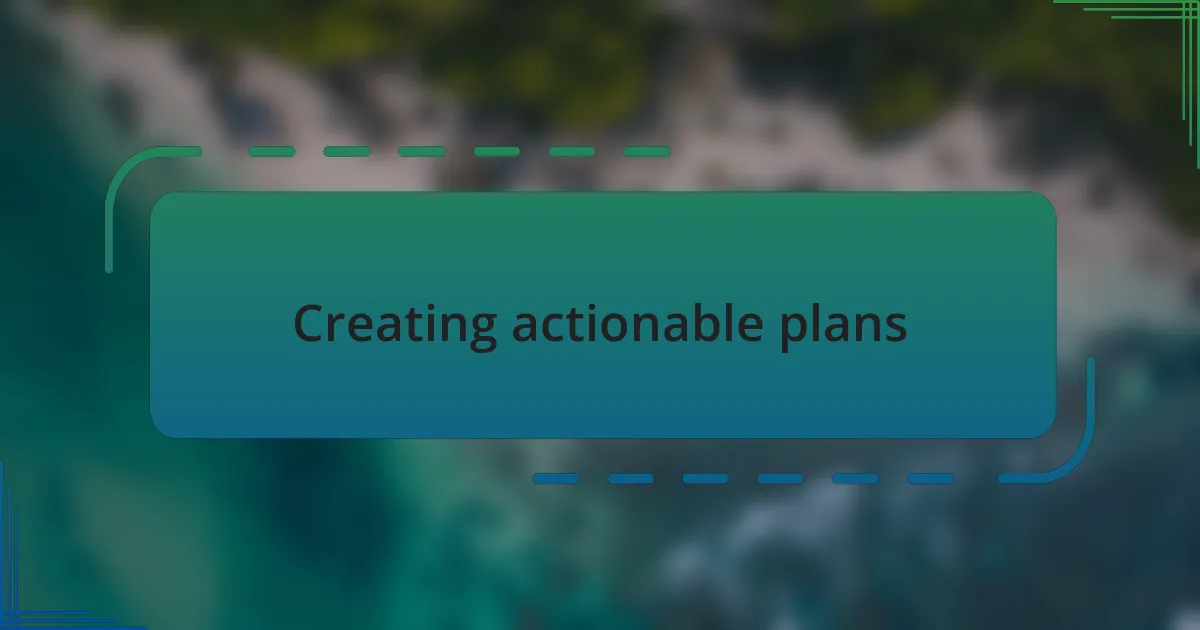
Creating actionable plans
When I embarked on the journey of sustainability, I quickly realized that merely having ideas wasn’t enough; I needed actionable plans. For instance, I started by breaking down larger goals into smaller, achievable tasks. Instead of just saying, “Let’s tackle plastic waste,” I encouraged my friends to bring their own reusable bags when we went shopping together. It was a simple step, but it created a communal commitment. Have you ever seen how collective action can feel more empowering than going solo?
In another instance, I organized a monthly clean-up day in our local park. The plan was straightforward: gather a group, set a date, and make it a social event. I crafted a flyer detailing not just the logistics but also the potential impact of our efforts. Seeing my friends and neighbors come together, armed with gloves and trash bags, stirred a deep sense of pride in our collective impact. Isn’t it amazing how little steps can grow into something much larger?
The real transformation for me came when I started setting measurable goals. For example, I aimed for my household to reduce energy consumption by 20%. I shared this goal with friends through social media, posting updates on our progress and encouraging them to join. Encouraging accountability turned the task into a friendly competition. But I still recall the sense of triumph when we hit our target: it wasn’t just about numbers; it was about proving to ourselves that we could make a tangible difference. Have you ever felt that rush of achievement from setting and reaching a goal? There’s nothing quite like it!
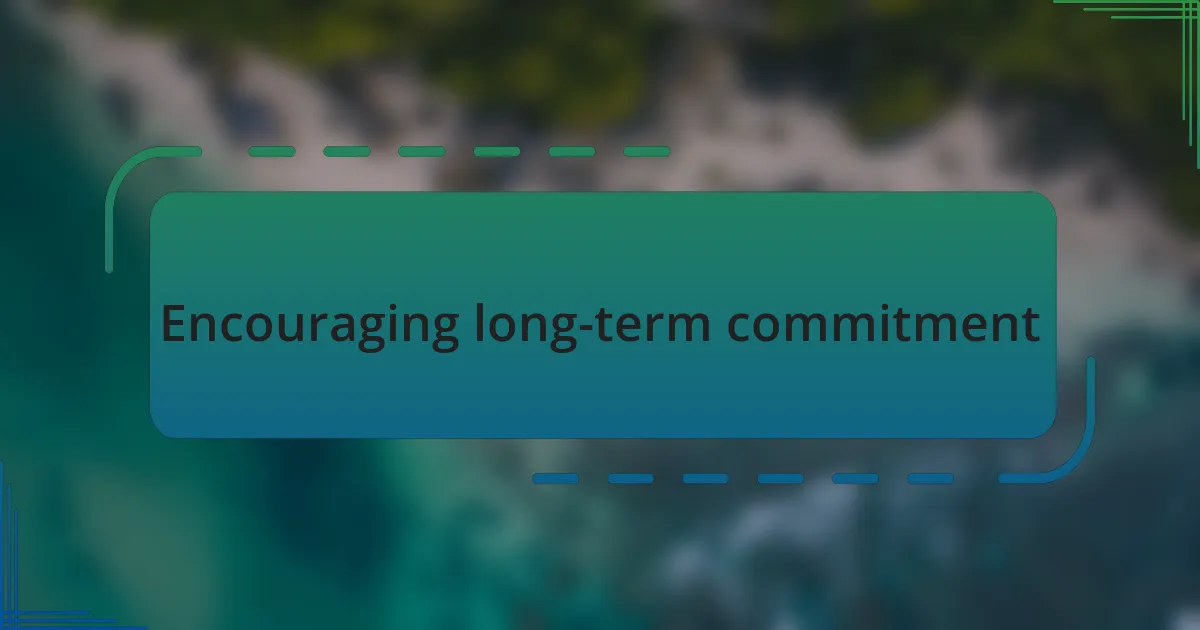
Encouraging long-term commitment
To foster long-term commitment in sustainability efforts, it’s crucial to create personal connections to the cause. I remember initiating a small garden project in my neighborhood. By inviting friends to plant their own vegetables, we not only grew a garden but also cultivated a sense of ownership. The excitement was palpable when we shared our harvests. How often do we find joy in tending to something we’ve nurtured together?
I believe regular check-ins can make a significant difference in sustaining motivation. In my experience, setting aside time every few months to discuss our progress—and any challenges—helped strengthen our commitment. During these gatherings, we would share not just successes, but also our struggles with staying consistent. This practice made our conversations feel open and honest, reinforcing the idea that we were in this together. Have you ever felt the weight of collective challenges lift through shared experiences?
Additionally, I found that celebrating milestones plays a pivotal role in maintaining enthusiasm. When our group reached a collective goal, like reducing waste by 50%, we would organize celebratory events. I can vividly recall the joy of hosting a potluck to reflect on what we had accomplished. It turned our hard work into a festive occasion, reminding everyone that our contributions truly mattered. Isn’t it inspiring to realize that celebrating progress fuels our commitment?
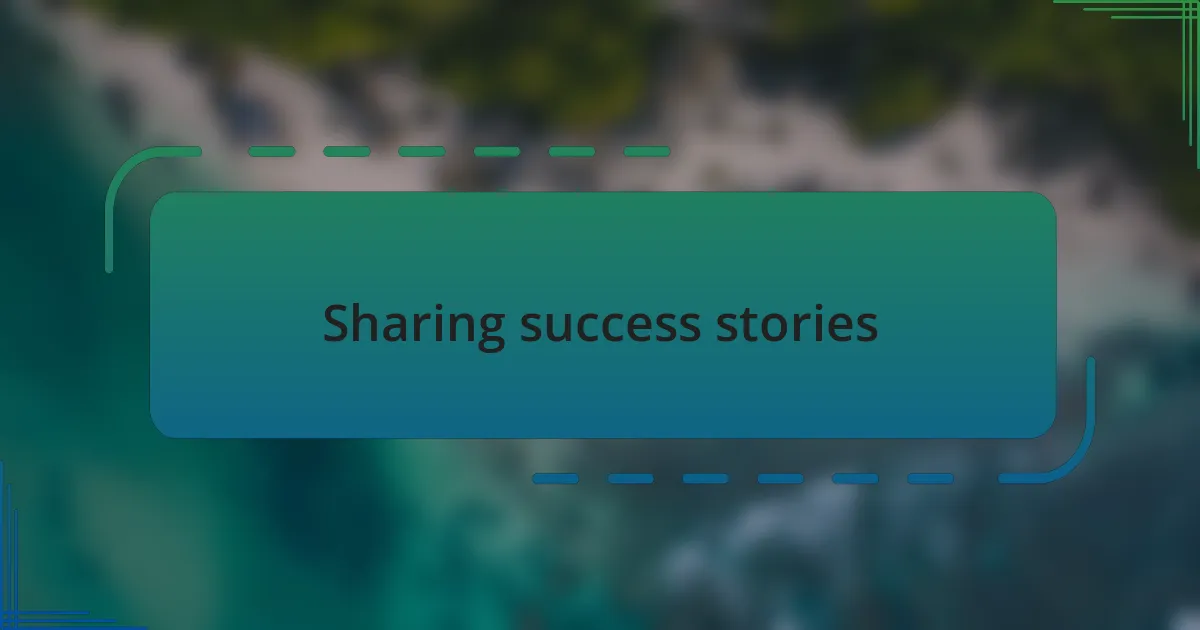
Sharing success stories
Sharing success stories is perhaps one of the most impactful ways to inspire others in sustainability. I remember when a local school implemented a recycling program that not only cut down on waste but also engaged students actively. Hearing the students share their excitement about how they had collected thousands of cans made me realize the power of community stories. Isn’t it rewarding to witness the enthusiasm of young minds when they see the tangible impact of their actions?
Another instance that stands out occurred during a neighborhood cleanup event. After we finished picking up litter, we gathered to share our experiences. One neighbor recounted how seeing the beach pristine after our effort prompted her to rethink her own habits on waste. That moment crystallized for me the importance of storytelling; it isn’t just about the cleanup but also about how participation reshaped perceptions. Can a simple story shift someone’s mindset and inspire them to take action?
In my experience, sharing success stories can create a ripple effect, encouraging others to engage. For instance, I once shared a brief story of our composting success at a community meeting. This simple act ignited curiosity among attendees, and several expressed interest in starting their own composting initiatives. It reinforced to me that narratives are powerful tools—always asking the question, how can a shared success not only motivate but also inspire collective action for the greater good?